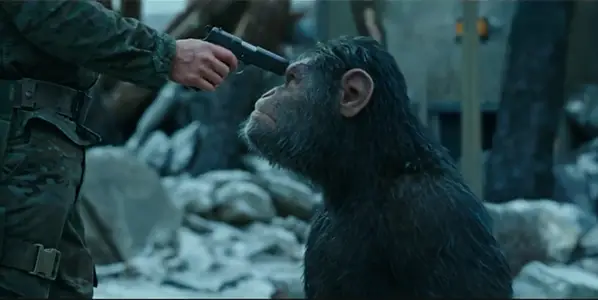Rendering Unto Caesar: The Will To Power In The PLANET OF THE APES Franchise

Brian Walter is a college professor by day and a…
What price power?
This old and endlessly resonant question rippled through the first two films of the rebooted Planet of the Apes franchise, and the prospect of a memorable final answer is the main reason I’ve been looking forward to the imminent release of War for the Planet of the Apes. It’s also why I’ve (probably unwisely) posted this admittedly speculative ‘pre-review’ based on the film’s advance publicity – or, more specifically, on what strike me as the most disturbing and thus, ironically, the most promising images in the trailers.
Setting up the climactic conflict between apes and humans, director Matt Reeves and cinematographer Michael Seresin use distant high-angle shots to show the human battalions marching in massive unison, cutting in to show the determined faces of the troops and, in a shallow focus insert shot, the symbolically centered, shaved head of Woody Harrelson’s commander. The visual sensibility cannily invokes the inexhaustibly instructive exemplar of Nazi and propaganda cinema, Leni Riefenstahl, who infamously imagined the triumph of Hitler’s genocidal designs on übermensch-ian will in glorious, even poetically mobile human geometries of the screen that would make Busby Berkeley proud.

So, fortunately (at least from a cynic’s perspective), it very much looks like the third film too will show how the will to power can incite a populace to generally heinous action. The previous two films in the Apes-reboot franchise (2011’s Rise of the Planet of the Apes and 2014’s Dawn of the Planet of the Apes) often struggle to balance Hollywood’s stock demands for reassuring, even hopeful endings against their unmistakable impulse to deliver a meaningful critique of human violence and corruption. Scenes of abductions, abuse, medical torture, treachery, abandonment, mass killings, and enslavement unapologetically undermine our delusions of civilization and morality. In these films, our will to power kills.
But, as Hollywood will pretty much always have it, such reasons for honest despair have been offset in these films by at least some reasons for optimism. Hopeless human nature seems a little less hopeless when we watch the scenes of heart-warming cross-species education, cooperation, sacrifice, and authentic moral imagination that the earlier films also incorporate. The corrupt, human-dominated world does come to an end in the first film, but it also sets up the promise of an impressively sustainable ape community that does, in fact, greet us at the beginning of the second film.
But beneath such hopeful elements (and the visceral thrills of the action scenes), the new Apes franchise clearly has harbored both darker and grander designs. A little bit like Children of Men, Alfonso Cuarón‘s devastating 2006 critique of the apocalyptic barrenness of our culture, the Apes films have repeatedly and earnestly dramatized everything that is worst in our human nature. In the midst of this bleak vision, the suggestion that we might, just might — with incredible effort, pushing on through defeats, losses, and great sorrow — find a way to cooperate and work communally probably springs more from box office imperatives than from any real hope for our future.
Both Sides Now
In their efforts to balance despair with signs of hope, the previous two Apes films also subtly achieve a careful (and thus box office-friendly) political flexibility. Like other 20th-Century Fox properties (such as the recent Logan), the Apes films have worked hard and effectively to straddle some of the ever-widening fault lines in rancorously partisan America, devising scenes and themes that make themselves available to pet platitudes of both the left and the right.
The first film in the series, for example, lends itself superbly to animal rights advocacy, opening with the harrowing capture and killing of chimpanzees in an African forest. Animal rights activists can continue to nod knowingly while watching the subsequent scenes of the captives’ torturously exploitive treatment in scientific laboratories. Topping off the film’s PETA-recruitment potential, we watch as Caesar, the series’ noble chimp hero, is horrifyingly imprisoned in a zoo where he is abused by a heedlessly nasty young blond man who could have made a plausible (if brief) cool-crowd villain in a slasher flick of the late 70s.
But that first Apes film and its follow-up also lend themselves to a fundamentally conservative reading: humans and apes (even those with artificially-boosted intelligence) cannot safely mix or even, finally, live together. No matter how hard and earnestly certain individual members of both species strive to overcome distrust and forestall violence, there can be no peace between them on the whole. For any proudly obdurate Confederate flag-defender who believes both that nature has established immutable differences among us and that those differences will finally, inevitably force us simply to isolate ourselves from each other, the Apes films offer plenty of grist.

The second film, in particular, unmistakably argues that only the strong and conquering will survive. Scenes of the apes temporarily enslaving humans near the end of the second film are — according to the reductive, self-serving version of the great naturalist’s teachings that we have lumped under the excruciating misnomer of ‘Social Darwinism’ — simply what has to happen: the stronger, smarter, ‘fitter’ creatures conquer the lesser and make them serve as distrusted and frankly unworthy creatural conveniences.
Machine Love?
In these efforts to appeal subtly to ticket-buyers across our political divides, the first two films have delivered a curiously mixed critique of deadly capitalist greed and the depredations of colonialism. In particular, they have notably targeted the humans’ unsustainable reliance on massive, artificial technologies. We humans simply can’t leave well enough alone in these films; we have to establish (or re-establish) structures and systems that reify our wills, enabling our endlessly fallible but restless, energetic egos.
The second film blends these themes together perhaps most signally in a scene that is at least as creepy as it is heart-warming. When the apes help the hapless humans to fix the generator and re-power their distant concrete compound, Gary Oldman’s leader, sitting alone in his dark chamber separate, hears an old, decrepit iPad powering up. Moments later, he finds himself (along with some of us viewers, no doubt) weeping over happy family images of his deceased wife and children.

But the symbolism remains chilling. This tellingly tender moment only becomes possible through the mediation of technology that requires massive, artificial power systems, ironically filtering a heart-warming, triumphal vision of tragically lost love through our painful, even pathetic 21st-century screen addictions. Galvanized by his twice-removed vision — by this cold, plastic pseudo-awakening of love offered not person to person, nor even person to photograph, but helpless person to ephemeral pixels — Oldman’s commander soon strides back out of his private tragedy purposefully, ready now to lead the surviving humans boldly and decisively. Nothing can hearten us millennial humans like finally getting our electronic toys back.
Losing Power
In addition, then, to their canny (and arguably cynical) political flexibility, the Apes films have so far offered up a treatise on the workings of power and the prices — both literal and moral — that we are willing to pay to obtain and wield it. And that is why the agitprop elements of the trailers hearten almost as much as they disturb.
It seems pretty much inevitable that the third film too will deliver at least some reassuring messages about compassion and hope to offset its frank dramatization of human corruption and violence. But whatever reasons for hope it may contrive, it appears (fortunately) that they will not detract from the franchise’s searching excoriation of our horrifying but very human designs on power — power over our environments, power over the fellow members of our communities, and power over the planet as a whole, to reduce it to a means to our potent will.

It’s impossible to predict from mere trailers how good a movie will finally be. And certainly, not everything that’s shown up on the Internet sparks confidence in War for the Planet of the Apes’s prospects for greatness. But if we can trust these chilling images of the killing business of recruiting for and waging war, then the film could render us a welcome service, rare in such tentpole fare. Hopefully, it too will hold up a broken mirror to show us once again that our will to power is anything but an actual triumph and that we will only achieve such power by exacting a terrible, terrible price.
What price does power exact in the Apes films?
War for the Planet of the Apes opens in wide release in the U. S. on July 14th.
Does content like this matter to you?
Become a Member and support film journalism. Unlock access to all of Film Inquiry`s great articles. Join a community of like-minded readers who are passionate about cinema - get access to our private members Network, give back to independent filmmakers, and more.
Brian Walter is a college professor by day and a hopelessly sleepy college professor by night. His work has appeared in a variety of literary and film studies publications, and he appears as an 'old coot' interviewer with a magic camera in the final chapter of Donald Harington's final novel, "Enduring." He lives a short walk from the St. Louis Zoo with his remarkably patient, loving wife and a quirky assortment of canine and feline familiars.













